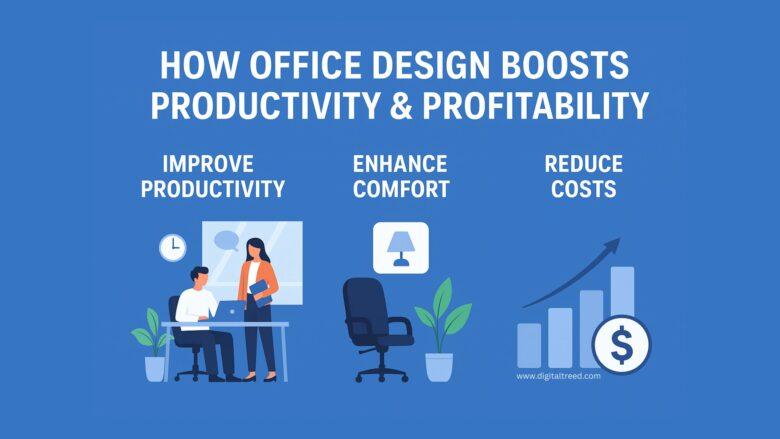In today’s competitive business environment, productivity and profitability go hand in hand. Companies often focus on strategies such as marketing, sales, and product development to drive revenue, but the design and functionality of office spaces play an equally critical role. An office that is thoughtfully organized, comfortable, and efficient can significantly enhance employee performance, reduce operational costs, and support a positive company culture. From layout and lighting to ergonomics and common areas, the physical environment affects every aspect of work life.
How Office Efficiency Boosts Productivity
A well-organized office layout is one of the most direct ways to improve productivity. Employees spend less time navigating cluttered spaces or searching for resources when the office is logically structured. Open workstations, designated collaboration zones, and quiet areas for focused work can all contribute to smoother workflows. For example, a layout that positions teams that frequently collaborate near each other can reduce time wasted walking across the office or communicating via inefficient channels.
Minimizing distractions is another key component. Offices with noisy equipment, poorly arranged desks, or poorly lit work areas can lead to lower concentration and longer task completion times. Incorporating quiet zones and adjustable spaces allows employees to switch between collaboration and individual focus as needed, improving efficiency and output.
Technology also plays a role in office efficiency. Easy access to shared resources, such as printers, storage, and digital tools, reduces downtime and allows employees to complete tasks faster. An efficient workspace ensures that technology supports workflow rather than creating bottlenecks, which directly impacts productivity and, ultimately, profitability.
Employee Comfort and Its Effect on Profitability
Comfortable employees are more engaged, less fatigued, and less likely to take unnecessary sick days. Ergonomic furniture, proper lighting, and climate control are essential components of a workspace that promotes health and well-being. Adjustable desks, supportive chairs, and monitor placement that reduces strain help prevent workplace injuries and reduce healthcare costs over time.
Comfortable office environments also boost morale and engagement. Employees who feel valued and cared for are more likely to be motivated, creative, and committed to the company. A positive work environment encourages retention, saving the business money on recruitment, onboarding, and training new staff. Providing flexible workspaces, such as breakout areas or quiet rooms, allows employees to work in ways that suit their tasks and personal preferences, enhancing overall productivity.
Even small adjustments can have a measurable impact. For instance, ensuring that communal spaces are comfortable and functional helps employees recharge and refocus, contributing to more consistent high performance throughout the day.
Cost Savings Through Efficient Office Design
Efficient office design isn’t just about productivity, as it can also reduce operational costs. Maximizing the use of available space ensures that every square foot contributes to business operations, reducing the need for costly expansions or additional leases. Open-plan layouts, shared workspaces, and well-organized storage areas minimize unused or wasted space, allowing businesses to make the most of their existing office footprint.
Energy efficiency is another cost-saving factor. Properly positioned lighting, smart thermostats, and energy-efficient HVAC systems lower utility bills and reduce environmental impact. Efficient layouts also simplify maintenance and cleaning, which can further reduce ongoing operational expenses. Sustainable practices, such as using eco-friendly materials or energy-saving equipment, may require an initial investment but deliver long-term savings and align with corporate social responsibility initiatives.
Supporting Employee Experience Through Commercial Amenities
While office layout and ergonomics are crucial, other facilities within the workplace contribute to employee satisfaction and productivity. For example, clean, functional, and well-maintained restrooms and shared spaces can have a profoundly positive impact on morale and comfort. Employees who have access to well-organized and hygienic amenities feel valued and supported, which can reduce stress and improve focus on their work.
Businesses looking to enhance these spaces may invest in quality commercial solutions. Durable and efficient restroom installations not only enhance the employee experience but also reflect the organization’s commitment to a professional and comfortable workplace. To find some beautiful, durable, and comfortable commercial bathroom partitions, visit https://onepointpartitions.com/. You will find commercial bathroom partitions that combine functionality, hygiene, and design to support employee comfort in the workplace. While this is a small part of the overall office, it demonstrates that attention to detail in facility management contributes to both satisfaction and efficiency.
Enhancing Company Culture and Client Perception
A well-designed office has implications beyond employee productivity—it also influences company culture and client perception. An organized and aesthetically pleasing workspace fosters a collaborative and positive atmosphere. Employees are more likely to communicate effectively, share ideas, and engage in problem-solving when the environment supports collaboration and transparency.
For clients and visitors, office design serves as a reflection of the business’s brand and values. Comfortable, clean, and thoughtfully arranged spaces convey professionalism, attention to detail, and a commitment to quality. Meeting rooms, lounges, and reception areas that are well-planned enhance client experiences, making them more likely to engage positively with the company and return for future interactions. In this way, office design indirectly supports revenue by encouraging client loyalty and strengthening business relationships.
Conclusion
Well-designed offices boost profitability through efficiency, productivity, and cost reduction. Strategic investment in office design enhances business performance, leading to employee satisfaction, impressed clients, and long-term financial gains by prioritizing both operational efficiency and employee comfort.

Leave a Reply